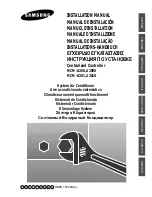
7-2. Control Specifications
7-2-1. Frequency Control
(1) Frequency Initial Setting
<Outline>
When starting compressor, or when conditions are varied due to the change of the room, the frequency must
be initialized according to the
⊿
D value of the indoor unit and the Q value of the indoor unit.
⊿
D signal :
Indoor frequency command
Q value
: Indoor unit output determined from indoor unit volume, air flow rate and the other factors.
Calculate
⊿
D value in each sampling time (20 seconds), and adjust the frequency according to its
difference from the frequency previously calculated.
(2) PI Control (Determine Frequency Up/Down by
⊿
D signal)
(2-1) P control
If the operation frequency is not change more than a certain fixed time, adjust the frequency up and down
according to the
⊿
D value, obtaining the fixed
⊿
D value.
When the
⊿
D value is small, lower the frequency.
When the
⊿
D value is large, increase the frequency.
(2-2) I control
The frequency upper and lower limits are set depending on indoor unit.
When low noise commands come from the indoor unit or when outdoor unit low noise or quiet commands
come from indoor unit, the upper limit frequency must be lowered than the usual setting.
(2-4) Upper and lower limit of frequency by PI control
•
When frequency is drooping, frequency management is carried.
•
For limiting lower limit, frequency management is carried out only when frequency rises.
(2-3) Frequency management when other controls are functioning
Prohibit to turn ON the compressor for 3 minutes after turning it off (except when defrosting).
7-2-2. 3-minutes Standby
When turning the compressor from OFF to ON, the upper limit of frequency must be set as follows.
(The function must not be used when defrosting).
7-2-3. Compressor Protection Function
FCG 3
FCG 2
FCG 1
TCG1
TCG2
TCG3
88
64
48
240
360
180
TCG 1sec
TCG 2sec
TCG 3sec
Time
Frequency
FCG3
FCG2
FCG1
29
















































